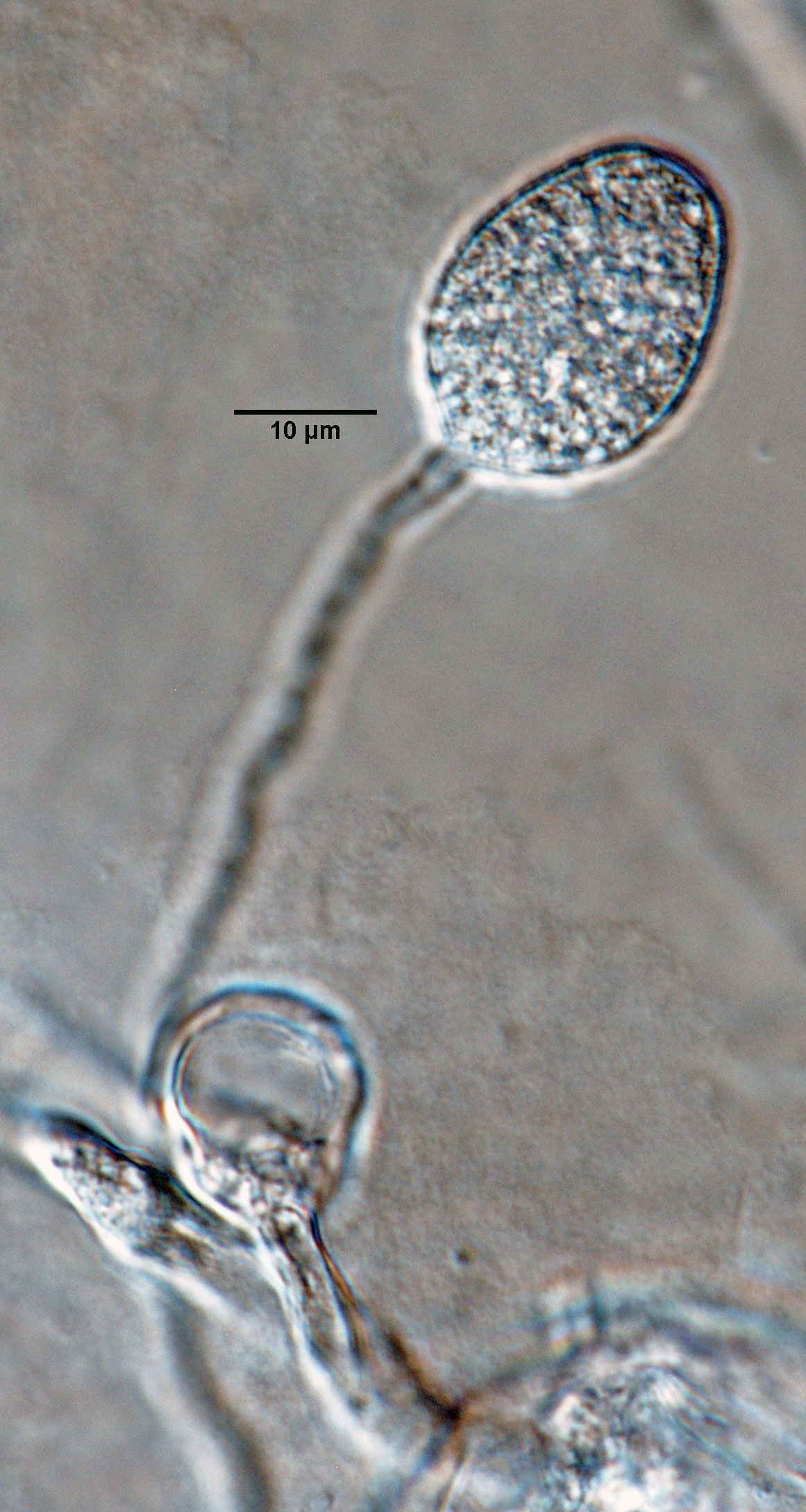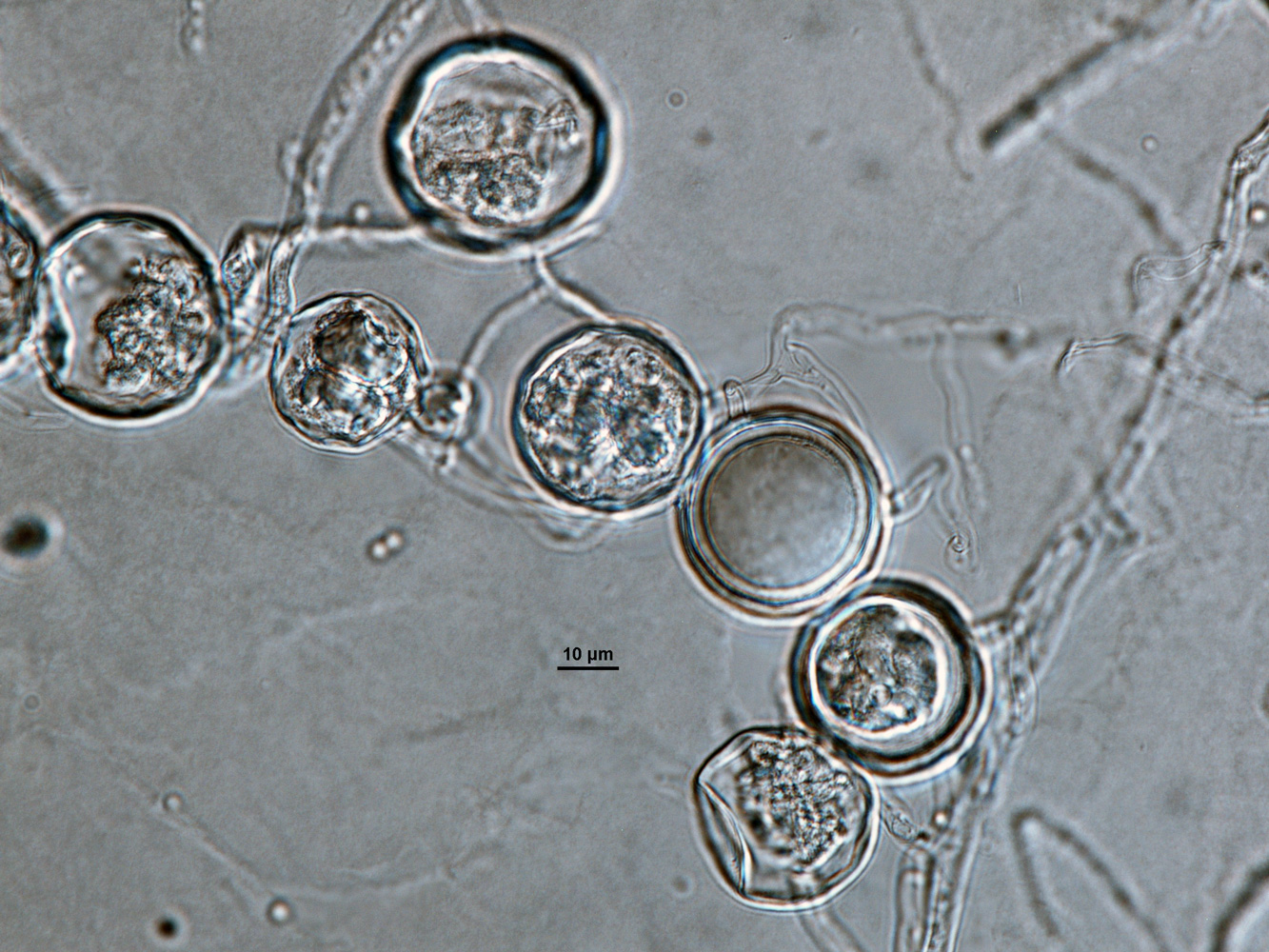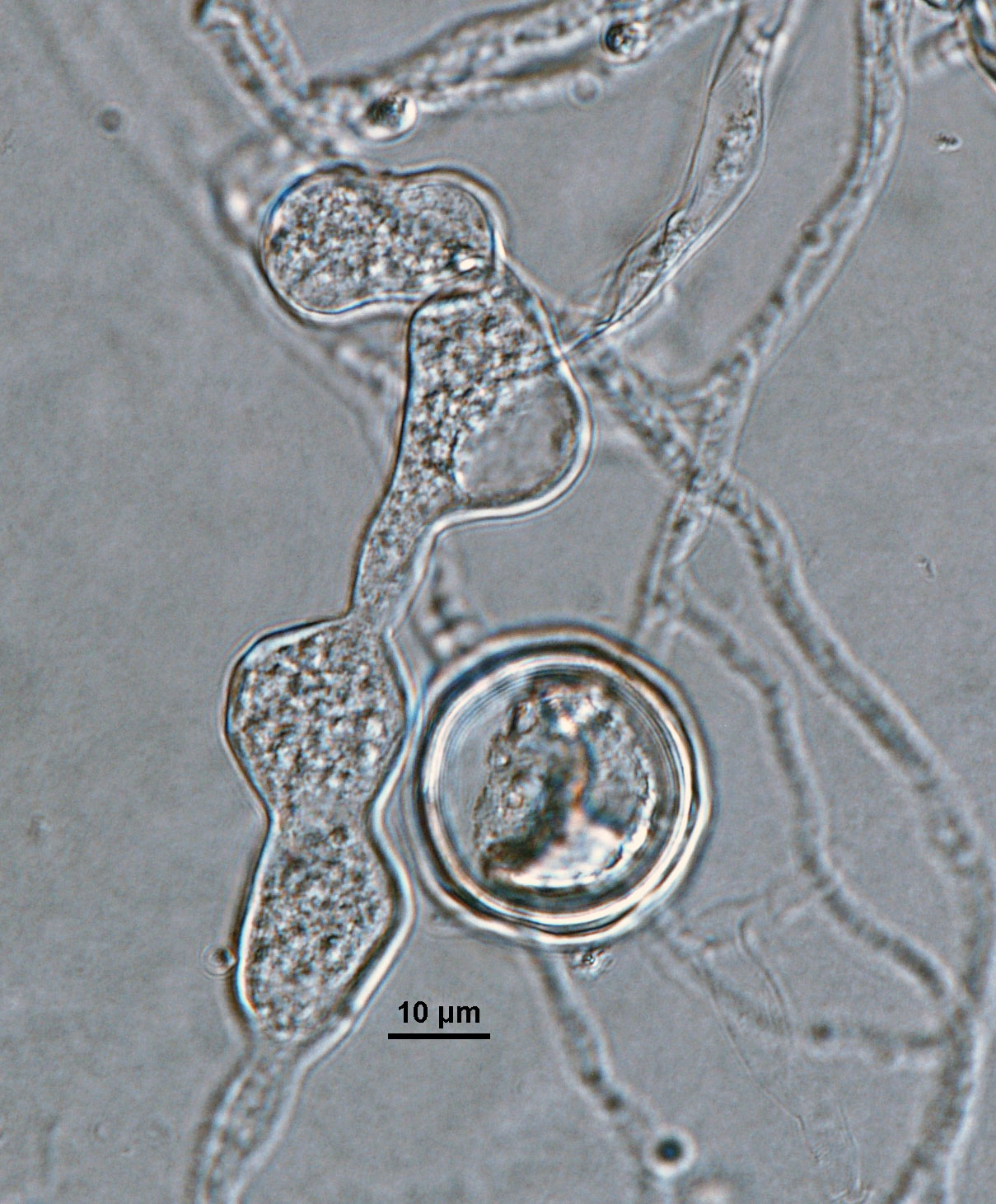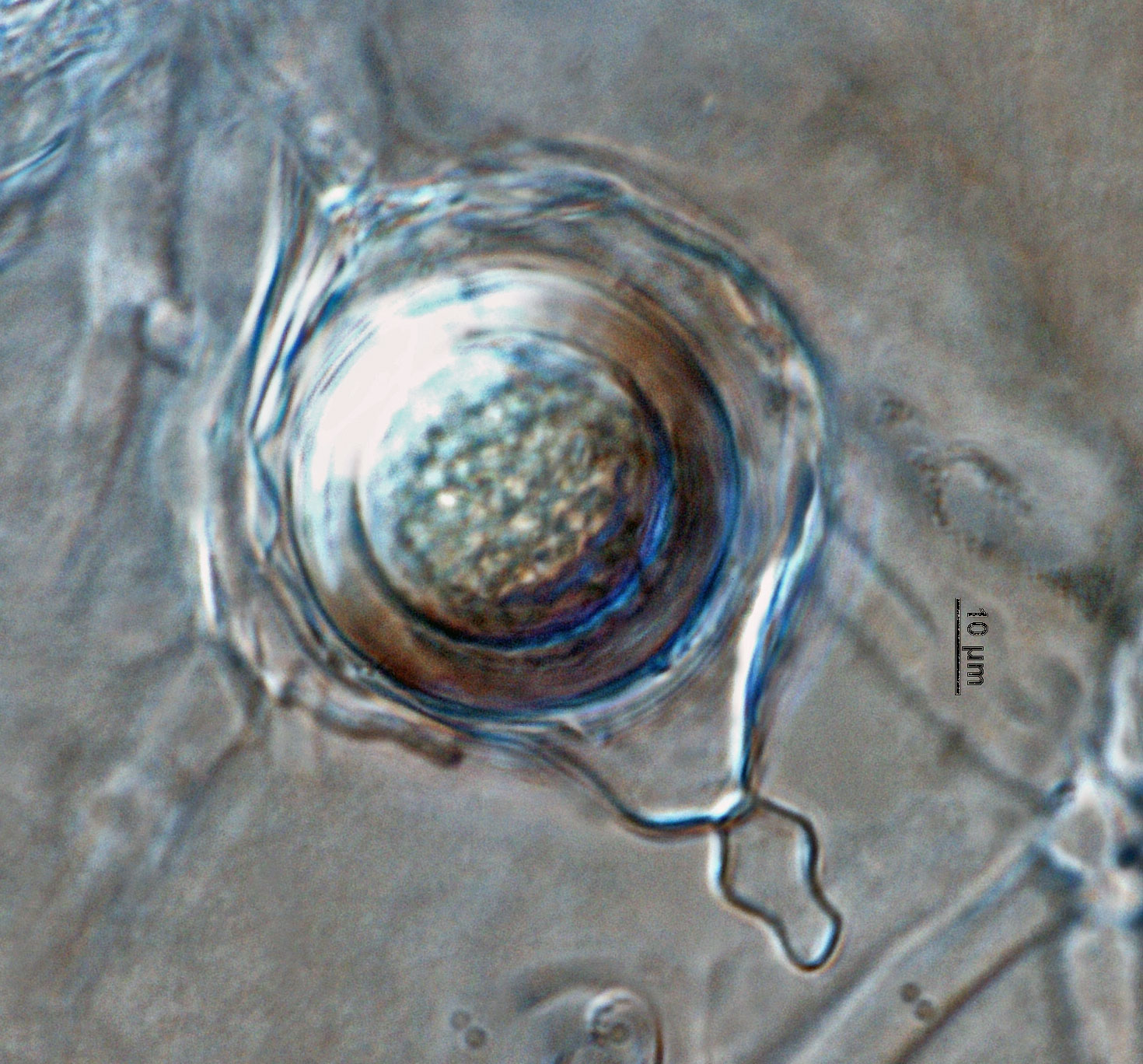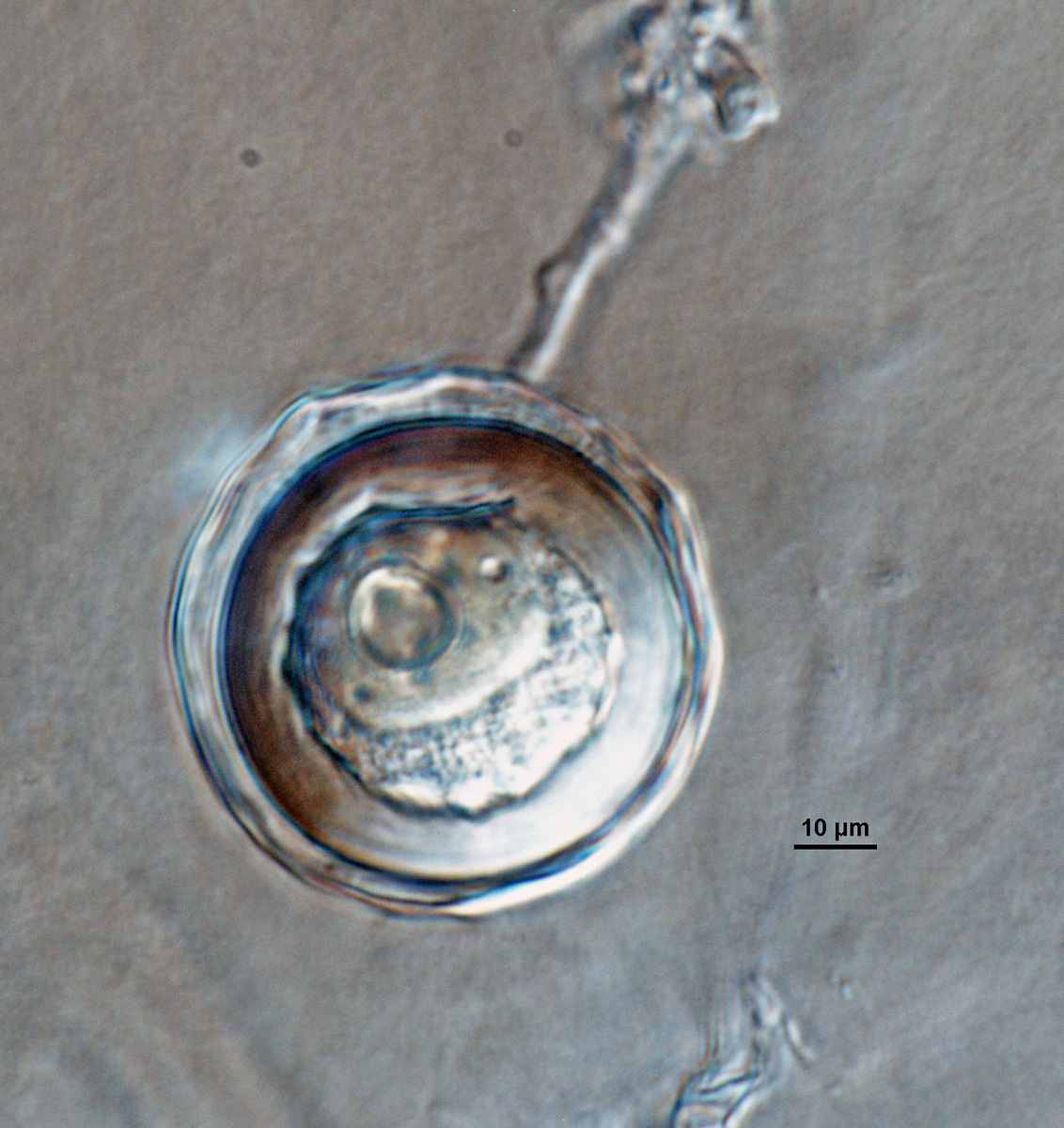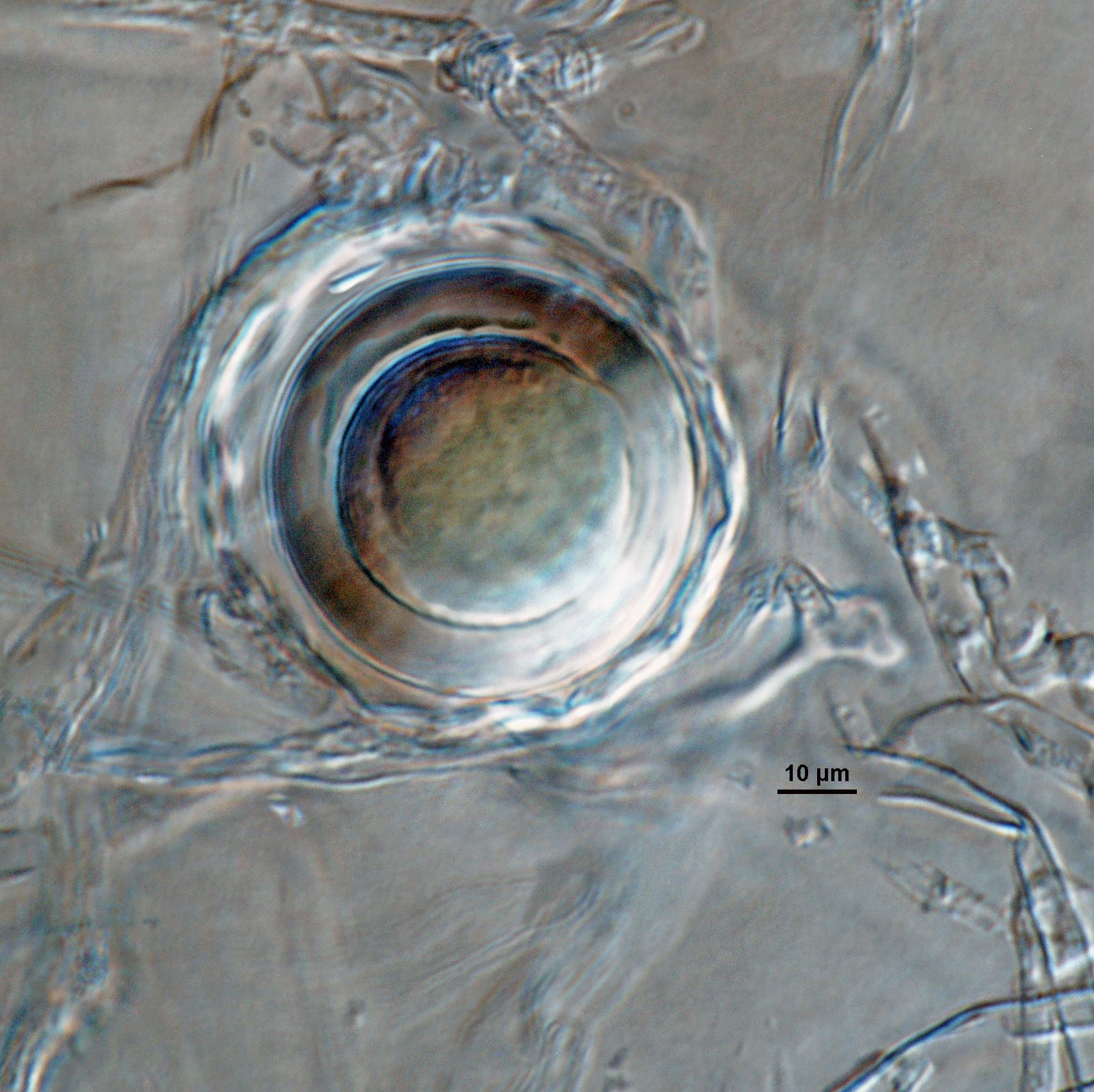Phytophthora insolita
|
Phytophthora spp. in subclade 9b: portion of the seven-loci ML phylogeny featuring the type cultures of 212 described species (by T. Bourret). Notice the position of P. insolita Ex-type CBS 691.79 = S&T BL 144. Gloria Abad, USDA S&T.
|
|
Phytophthora spp. in subclade 9b: Morphological Tabular key (PDF) and Tabular key legends (PDF) in IDphy2 KEY SECTION. Notice the data of P. insolita Ex-type CBS 691.79 = S&T BL 144. Gloria Abad, USDA S&T.
|
|
Phytophthora insolita (CPHST BL 144) colonies of the ex-type grown for 7 days on (a) V8® Agar, (b) potato dextrose agar, and (c) malt extract agar; photo by Krysta Jennings and Leandra Knight, USDA-APHIS-PPQ |
|
Phytophthora insolita (ex-type CPHST BL 144) asexual and sexual phases: (a, b) nonpapillated persistent sporangia originated in unbranched sporangiophores; (c) internal proliferation; (d) thin-walled chlamydospores and thin-walled oospore (red arrow), (e, f) hyphal swellings and oospores, (g–i) sexual stage without antheridia rarely produced; photos by Gloria Abad, USDA-APHIS-PPQ. |
|
Phytophthora insolita (ex-type CPHST BL 144) asexual phase: nonpapillated persistent sporangium originated in unbranched sporangiophore; photo by Gloria Abad, USDA-APHIS-PPQ. |
|
Phytophthora insolita (ex-type CPHST BL 144) asexual phase: nonpapillated persistent sporangium originated in unbranched sporangiophore; photo by Gloria Abad, USDA-APHIS-PPQ. |
|
Phytophthora insolita (ex-type CPHST BL 144) asexual phase: internal proliferation of sporangium; photo by Gloria Abad, USDA-APHIS-PPQ. |
|
Phytophthora insolita (ex-type CPHST BL 144) asexual and sexual phases: thin-walled chlamydospores and thin-walled oospore; photo by Gloria Abad, USDA-APHIS-PPQ. |
|
Phytophthora insolita (ex-type CPHST BL 144) asexual and sexual phases: hyphal swellings and oospores; photo by Gloria Abad, USDA-APHIS-PPQ. |
|
Phytophthora insolita (ex-type CPHST BL 144) asexual and sexual phases: hyphal swellings and oospores; photo by Gloria Abad, USDA-APHIS-PPQ. |
|
Phytophthora insolita (ex-type CPHST BL 144): sterile sexual stage without antheridia, rarely produced; photo by Gloria Abad, USDA-APHIS-PPQ. |
|
Phytophthora insolita (ex-type CPHST BL 144) sexual phase: sterile sexual stage without antheridia, rarely produced; photo by Gloria Abad, USDA-APHIS-PPQ. |
|
Phytophthora insolita (ex-type CPHST BL 144) sexual phase: sterile sexual stage without antheridia, rarely produced; photo by Gloria Abad, USDA-APHIS-PPQ. |
Name and publication
Phytophthora insolita Ann & W.H. Ko (1981)
Ann PJ and Ko WH. 1980. Phytophthora insolita, a new species from Taiwan. Mycologia 72: 1180–1185.
Nomenclature
from Ann and Ko (1980)
Mycobank
Etymology
Latin, insolitus (unusual), referring to sex organs of the species
Typification
Type: TAIWAN, isolated from soil in citrus orchard by floating pieces of young citrus leaves on soil slurries from from Yunching, Changhua, collected in 1979 by P. J. Ann TAI 5131 (holotype: dried culture), Herbarium of Department of Botany, National Taiwan University, Taipei, Taiwan
Ex-type: CBS 691.79 and ATCC 38789
Ex-type in other collections
(ET) CBS 691.79, ATCC 38789 (MCI), CABI IMI288805 (PA), WPC P6195, CMW 31063, PMC 5-1 (Ko), S&T BL 144 (Abad), 38E1 (Hong)
Molecular identification
Voucher sequences for barcoding genes (ITS rDNA and COI) of the ex-type (see Molecular protocols page)
Phytophthora insolita isolate CPHST BL 144 (= P6195 WPC) = ITS rDNA MG865515, COI MH136909
Voucher sequences for Molecular Toolbox with seven genes (ITS, β-tub, COI, EF1α, HSP90, L10, and YPT1
(see Molecular protocols page) (In Progress)
Voucher sequences for Metabarcoding High-throughput Sequencing (HTS) Technologies [Molecular Operational Taxonomic Unit (MOTU)]
(see Molecular protocols page) (In Progress)
Sequences with multiple genes for ex-type in other sources
- NCBI: Phytophthora insolita CPHST BL 144
- NCBI: Phytophthora insolita P6195
- EPPO-Q-bank: Phytophthora insolita CBS 691.79
- BOLDSYSTEMS: Phytophthora insolita (barcoding COI & ITS)
Position in multigenic phylogeny with 7 genes (ITS, β-tub, COI, EF1α, HSP90, L10, and YPT1)
Clade 9b
Morphological identification
Colonies and cardinal temperatures
Colony colony:
assemblage of hyphae which usually develops form a single source and grows in a coordinated way
morphology on V8-A, PDA, and MEA with chrysanthemum pattern. The minimum temperature for growth is 9°C, the optimum is 32°C, and the maximum is 38°C.
Asexual phase
Sporangia nonpapillated; persistentpersistent:
pertaining to sporangia that remain attached to the sporangiophore and do not separate or detach easily (cf. caducous)
; ovoidovoid:
egg-shaped, with the widest part at the base of the sporangium and the narrow part at the apex
, obpyriformobpyriform:
inversely pear-shaped, i.e. with the widest part at the point of attachment (cf. pyriform)
, ellipsoidellipsoid:
refers to a solid body that forms an ellipse in the longitudinal plane and a circle in cross section; many fungal spores are ellipsoidal or elliptic
(38–70 µm long x 27–40 µm wide), sometimes with tapered bases; presenting internal nested and extended proliferationextended proliferation:
a type of internal proliferation in which the sporangiophore originates from inside of an empty sporangium, and continues to grow through and out of the old sporangium
; originated in unbranched sporangiophores. Hyphal swellings globose, subglobose, elongate, obpyriformobpyriform:
inversely pear-shaped, i.e. with the widest part at the point of attachment (cf. pyriform)
, produced single or in lobate chains. ChlamydosporesChlamydospores:
an asexual spore with a thickened inner wall that is delimited from the mycelium by a septum; may be terminal or intercalary, and survives for long periods in soil
globose and thin-walled.
Sexual phase
Sterile. Globose smooth-walled oogoniaoogonia:
the female gametangium in which the oospore forms after fertilization by the antheridium
with no antheridiaantheridia:
the male gametangium; a multinucleate, swollen hyphal tip affixed firmly to the wall of the female gametangium (the oogonium)
and pleroticplerotic:
pertaining to an oospore that fills the oogonium (cf. aplerotic)
oosporesoospores:
zygote or thick-walled spore that forms within the oogonium after fertilization by the antheridium; may be long-lived
are sometimes produced in single cultures.
Specimen(s) evaluated
Phytophthora insolita ex-type CPHST BL 144 = P6195 (World Phytophthora Collection)
Hosts and distribution
Distribution: Asia (India, Taiwan), North America (USA: OH)
Substrate: soil, leaves
Disease note: foliar necrotic lesions and twig dieback (Testa et al. 2005)
Host: Rhododendron sp. (Ericaceae); able to infect Malus domestica (apple, Rosaceae) and Cucumis sativus (cucumber, Cucurbitaceae) fruits when inoculated (Erwin & Ribeiro 1996)
Retrieved January 31, 2018 from U.S. National Fungus Collections Nomenclature Database.
Additional info:
Host: Citrus spp.
Additional references and links
- SMML USDA-ARS: Phytophthora insolita
- EPPO Global Database: Phytophthora insolita
- Forest Phytophthora of the world: Phytophthora insolita
- CABI Digital Library: Phytophthora insolita
- Encyclopedia of Life (EOL): Phytophthora insolita
- Index Fungorum (IF): Phytophthora insolita
- Google All Phytophthora insolita
- Google Images Phytophthora insolita
- Google Scholar Phytophthora insolita
Fact sheet author
Z. Gloria Abad, Ph.D., USDA-APHIS-PPQ-S&T Plant Pathogen Confirmatory Diagnostics Laboratory (PPCDL), United States of America.


